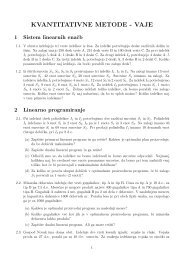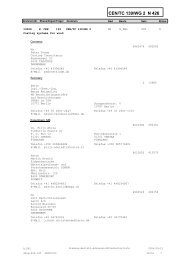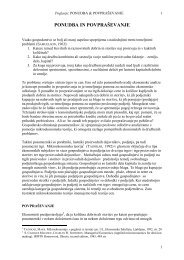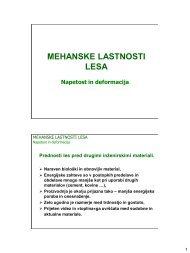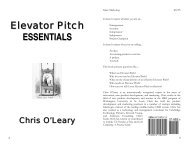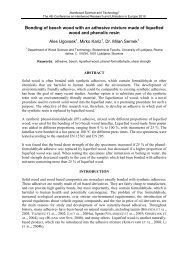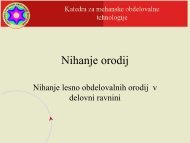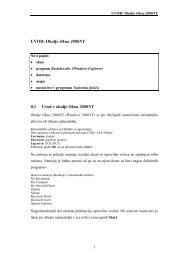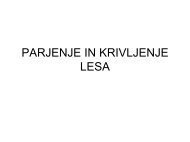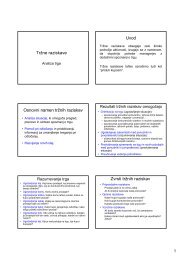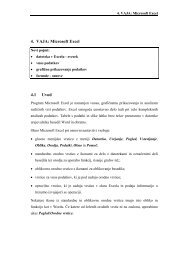Influence of carboxylic acids on fixation of copper in wood ...
Influence of carboxylic acids on fixation of copper in wood ...
Influence of carboxylic acids on fixation of copper in wood ...
- No tags were found...
You also want an ePaper? Increase the reach of your titles
YUMPU automatically turns print PDFs into web optimized ePapers that Google loves.
Wood Sci Technol (2005) 39: 685–693DOI 10.1007/s00226-005-0031-zORIGINALM. Humar Æ P. Kalan Æ M. Sˇentjurc Æ F. Pohleven<str<strong>on</strong>g>Influence</str<strong>on</strong>g> <str<strong>on</strong>g>of</str<strong>on</strong>g> <str<strong>on</strong>g>carboxylic</str<strong>on</strong>g> <str<strong>on</strong>g>acids</str<strong>on</strong>g> <strong>on</strong> fixati<strong>on</strong> <str<strong>on</strong>g>of</str<strong>on</strong>g> <strong>copper</strong> <strong>in</strong> <strong>wood</strong>impregnated with <strong>copper</strong> am<strong>in</strong>e based preservativesReceived: 17 February 2005 / Published <strong>on</strong>l<strong>in</strong>e: 7 October 2005Ó Spr<strong>in</strong>ger-Verlag 2005Abstract The importance <str<strong>on</strong>g>of</str<strong>on</strong>g> <strong>copper</strong>/am<strong>in</strong>e based preservatives is <strong>in</strong>creas<strong>in</strong>g.Leach<strong>in</strong>g <str<strong>on</strong>g>of</str<strong>on</strong>g> <strong>copper</strong> from <strong>wood</strong> preserved with these soluti<strong>on</strong>s is still higher thanleach<strong>in</strong>g from <strong>wood</strong> impregnated with <strong>copper</strong> chromium <strong>on</strong>es. In order todecrease leach<strong>in</strong>g, different <str<strong>on</strong>g>carboxylic</str<strong>on</strong>g> <str<strong>on</strong>g>acids</str<strong>on</strong>g> (octanoic, 2-ethylhexanoic, decanoic)were added to <strong>copper</strong>/am<strong>in</strong>e/bor<strong>on</strong> aqueous soluti<strong>on</strong>s. An experiment <str<strong>on</strong>g>of</str<strong>on</strong>g>leach<strong>in</strong>g <str<strong>on</strong>g>of</str<strong>on</strong>g> <strong>copper</strong> from Norway spruce was performed accord<strong>in</strong>g to themodified standard procedure (EN 1250). Results c<strong>on</strong>firmed that <str<strong>on</strong>g>carboxylic</str<strong>on</strong>g><str<strong>on</strong>g>acids</str<strong>on</strong>g> significantly improve <strong>copper</strong> fixati<strong>on</strong>. The best fixati<strong>on</strong> was determ<strong>in</strong>ed <strong>in</strong>specimens impregnated with the preservative soluti<strong>on</strong>s c<strong>on</strong>sist<strong>in</strong>g <str<strong>on</strong>g>of</str<strong>on</strong>g> <strong>copper</strong>,ethanolam<strong>in</strong>e, boric acid and octanoic acid. From such <strong>wood</strong>, <strong>on</strong>ly 1.6% <str<strong>on</strong>g>of</str<strong>on</strong>g><strong>copper</strong> was leached.Introducti<strong>on</strong>In the last century <strong>copper</strong> biocides were ma<strong>in</strong>ly comb<strong>in</strong>ed with chromium andarsenic or bor<strong>on</strong> to improve its fixati<strong>on</strong> and resistance aga<strong>in</strong>st <strong>in</strong>sects. However,the use <str<strong>on</strong>g>of</str<strong>on</strong>g> chromium <strong>in</strong> <strong>wood</strong> preservatives is foreseen to be significantly limitedor even banned <strong>in</strong> several European countries. In order to use <strong>copper</strong> as fungicide<strong>in</strong> the future, new soluti<strong>on</strong>s to improve Cu fixati<strong>on</strong> were developed.Amm<strong>on</strong>ia was found to be a very effective <strong>copper</strong> fixative l<strong>on</strong>g time ago, butdue to its emissi<strong>on</strong>s this formulati<strong>on</strong> never came <strong>in</strong>to extensive commercial use.Later, amm<strong>on</strong>ia was replaced with am<strong>in</strong>es; particularly ethanolam<strong>in</strong>e wasfound a very effective <strong>copper</strong> fixative (Zhang and Kamdem 2000). Nowadays,ethanolam<strong>in</strong>e is a comp<strong>on</strong>ent <str<strong>on</strong>g>of</str<strong>on</strong>g> several <strong>copper</strong> based <strong>wood</strong> preservatives thatM. Humar (&) Æ F. PohlevenBiotechnical Faculty, Department <str<strong>on</strong>g>of</str<strong>on</strong>g> Wood Science and Technology,University <str<strong>on</strong>g>of</str<strong>on</strong>g> Ljubljana, jamnikarjeva 101, 1000, Ljubljana, SloveniaE-mail: miha.humar@bf.uni-lj.siP. KalanSlovenian Forestry Institute, Ljubljana, SloveniaM. Sˇ entjurcInstitute Jozef Stefan, Ljubljana, Slovenia
686are available <strong>in</strong> the market. This <strong>in</strong>cludes <strong>copper</strong>-quat, <strong>copper</strong> dimethyl-dithiocarbamateand <strong>copper</strong> azole. Copper–am<strong>in</strong>e relati<strong>on</strong>ship significantly <strong>in</strong>fluencesthe performance <str<strong>on</strong>g>of</str<strong>on</strong>g> the preserved <strong>wood</strong>. In the previous researches, it wasfigured out that <strong>copper</strong>–am<strong>in</strong>e molar ratio significantly affects the penetrati<strong>on</strong>,fixati<strong>on</strong> and performance <str<strong>on</strong>g>of</str<strong>on</strong>g> the preservative (Zhang and Kamdem 2000).However, leach<strong>in</strong>g <str<strong>on</strong>g>of</str<strong>on</strong>g> <strong>copper</strong> from <strong>copper</strong>/am<strong>in</strong>e preserved <strong>wood</strong> is stillhigher compared to <strong>wood</strong> impregnated with <strong>copper</strong>/chromium formulati<strong>on</strong>. Inearlier papers it was reported that the presence <str<strong>on</strong>g>of</str<strong>on</strong>g> octanoic acid significantlydecreases the leach<strong>in</strong>g <str<strong>on</strong>g>of</str<strong>on</strong>g> <strong>copper</strong> from preserved <strong>wood</strong> (Humar et al. 2003). Inorder to elucidate the leach<strong>in</strong>g <str<strong>on</strong>g>of</str<strong>on</strong>g> <strong>copper</strong> from <strong>wood</strong> preserved with differentcomb<strong>in</strong>ati<strong>on</strong>s <str<strong>on</strong>g>of</str<strong>on</strong>g> <strong>copper</strong>, am<strong>in</strong>es and <str<strong>on</strong>g>carboxylic</str<strong>on</strong>g> <str<strong>on</strong>g>acids</str<strong>on</strong>g>, the present research wascarried out.Materials and methodsTreatment soluti<strong>on</strong>sTo determ<strong>in</strong>e the <strong>in</strong>fluence <str<strong>on</strong>g>of</str<strong>on</strong>g> <str<strong>on</strong>g>carboxylic</str<strong>on</strong>g> <str<strong>on</strong>g>acids</str<strong>on</strong>g> <strong>on</strong> leach<strong>in</strong>g <str<strong>on</strong>g>of</str<strong>on</strong>g> <strong>copper</strong> fromimpregnated <strong>wood</strong>, 90 different aqueous soluti<strong>on</strong>s were prepared. Am<strong>on</strong>g these,30 formulati<strong>on</strong>s that exhibited good solubility and did not have precipitateswere chosen (Table 1). Preservative soluti<strong>on</strong>s that were <strong>in</strong>vestigated c<strong>on</strong>sisted <str<strong>on</strong>g>of</str<strong>on</strong>g><strong>copper</strong>(II) sulphate, am<strong>in</strong>e, <str<strong>on</strong>g>carboxylic</str<strong>on</strong>g> acid and boric acid. C<strong>on</strong>centrati<strong>on</strong> <str<strong>on</strong>g>of</str<strong>on</strong>g> Cu<strong>in</strong> the soluti<strong>on</strong> was 1% <strong>in</strong> all the <strong>in</strong>vestigated soluti<strong>on</strong>s. Three different am<strong>in</strong>es(ethanolam<strong>in</strong>e, diethanolam<strong>in</strong>e, triethanolam<strong>in</strong>e) and also three <str<strong>on</strong>g>carboxylic</str<strong>on</strong>g><str<strong>on</strong>g>acids</str<strong>on</strong>g> (octanoic, 2-ethylhexanoic, decanoic) were used for the preparati<strong>on</strong> <str<strong>on</strong>g>of</str<strong>on</strong>g> thesoluti<strong>on</strong>s as well (Table 1).Impregnati<strong>on</strong>Specimens (1.5·2.5·5.0 cm) made <str<strong>on</strong>g>of</str<strong>on</strong>g> Norway spruce (Picea abies) were vacuumimpregnated accord<strong>in</strong>g to the EN 113 procedure (ECS 1989) with differentpreservative soluti<strong>on</strong>s listed <strong>in</strong> Table 1. The treatment <str<strong>on</strong>g>of</str<strong>on</strong>g> the <strong>wood</strong> specimensresulted <strong>in</strong> a soluti<strong>on</strong> uptake <str<strong>on</strong>g>of</str<strong>on</strong>g> about 400 kg/m 3 . Later, the specimens werec<strong>on</strong>diti<strong>on</strong>ed for 4 weeks, the first 2 weeks <strong>in</strong> closed chambers, the third week <strong>in</strong>half closed and the fourth week <strong>in</strong> open <strong>on</strong>es. Prior to leach<strong>in</strong>g, specimens werestored at 25°C, 65% RH.Leach<strong>in</strong>g procedureLeach<strong>in</strong>g was performed accord<strong>in</strong>g to the modified EN 1250 (ECS 1994) procedure.The end gra<strong>in</strong>s <str<strong>on</strong>g>of</str<strong>on</strong>g> the samples were sealed with a two-comp<strong>on</strong>ent epoxycoat<strong>in</strong>g. Afterwards, n<strong>in</strong>e specimens, treated with the same soluti<strong>on</strong>, were put<strong>in</strong>to three vessels and positi<strong>on</strong>ed with a ballast<strong>in</strong>g device. Three hundred grams<str<strong>on</strong>g>of</str<strong>on</strong>g> distilled water was added and the vessel with its c<strong>on</strong>tent was shaken with thefrequency <str<strong>on</strong>g>of</str<strong>on</strong>g> 55 m<strong>in</strong> )1 . Water was replaced seven times daily. Afterwards,atomic absorpti<strong>on</strong> spectroscopy (AAS) analyses <str<strong>on</strong>g>of</str<strong>on</strong>g> the leachate were performedand percentages <str<strong>on</strong>g>of</str<strong>on</strong>g> leached <strong>copper</strong> were calculated. In order to compare themodified method with the standard <strong>on</strong>e, specimens impregnated with Cu(II)sulphate were used as reference.
688The value <str<strong>on</strong>g>of</str<strong>on</strong>g> A II is given by the spac<strong>in</strong>g between the comp<strong>on</strong>ents <str<strong>on</strong>g>of</str<strong>on</strong>g> the hyperf<strong>in</strong>epattern, measured <strong>in</strong> mT. However, the value <str<strong>on</strong>g>of</str<strong>on</strong>g> A^ is frequently unresolved.Results and discussi<strong>on</strong>In order to compare the modified leach<strong>in</strong>g procedure used <strong>in</strong> this experimentwith the standard <strong>on</strong>e, specimens treated with <strong>copper</strong> sulphate were also lea-Fig. 1 EPR spectra <str<strong>on</strong>g>of</str<strong>on</strong>g> three different <strong>copper</strong>/am<strong>in</strong>e based soluti<strong>on</strong>s recorded at 293 K (a), orat 150 K (b) and <strong>wood</strong> impregnated with <strong>copper</strong>/am<strong>in</strong>e based soluti<strong>on</strong>s recorded at 293 K (c)
ched. Leach<strong>in</strong>g <str<strong>on</strong>g>of</str<strong>on</strong>g> these specimens resulted <strong>in</strong> a <strong>copper</strong> loss <str<strong>on</strong>g>of</str<strong>on</strong>g> 48.2%, which iscomparable with the results determ<strong>in</strong>ed accord<strong>in</strong>g to the standard procedure(Humar et al. 2003). This result c<strong>on</strong>firms that modificati<strong>on</strong> <str<strong>on</strong>g>of</str<strong>on</strong>g> the method didnot significantly <strong>in</strong>fluence the leach<strong>in</strong>g rates compared to the standard procedure.<str<strong>on</strong>g>Influence</str<strong>on</strong>g> <str<strong>on</strong>g>of</str<strong>on</strong>g> <str<strong>on</strong>g>carboxylic</str<strong>on</strong>g> <str<strong>on</strong>g>acids</str<strong>on</strong>g>The most important c<strong>on</strong>tributi<strong>on</strong> <str<strong>on</strong>g>of</str<strong>on</strong>g> the present research is the elucidati<strong>on</strong> <str<strong>on</strong>g>of</str<strong>on</strong>g><str<strong>on</strong>g>carboxylic</str<strong>on</strong>g> acid’s <strong>in</strong>fluence <strong>on</strong> <strong>copper</strong> leach<strong>in</strong>g from preserved <strong>wood</strong> (Table 1).It is reported that from the impregnated <strong>wood</strong> treated with <strong>copper</strong>/ethanolam<strong>in</strong>esoluti<strong>on</strong>, between 15 and 22% <str<strong>on</strong>g>of</str<strong>on</strong>g> <strong>copper</strong> was leached (Humar et al.2003). Additi<strong>on</strong> <str<strong>on</strong>g>of</str<strong>on</strong>g> <str<strong>on</strong>g>carboxylic</str<strong>on</strong>g> <str<strong>on</strong>g>acids</str<strong>on</strong>g> decreased the leech<strong>in</strong>g <str<strong>on</strong>g>of</str<strong>on</strong>g> <strong>copper</strong> fromimpregnated <strong>wood</strong> significantly. Am<strong>on</strong>g different <str<strong>on</strong>g>carboxylic</str<strong>on</strong>g> <str<strong>on</strong>g>acids</str<strong>on</strong>g> and am<strong>in</strong>es,comb<strong>in</strong>ati<strong>on</strong> <str<strong>on</strong>g>of</str<strong>on</strong>g> octanoic acid and ethanolam<strong>in</strong>e was found the most effective.From <strong>wood</strong> impregnated with preservative soluti<strong>on</strong> CuEa6O1B, 2.0% <str<strong>on</strong>g>of</str<strong>on</strong>g> <strong>copper</strong>was leached. However, if we <strong>in</strong>creased the c<strong>on</strong>centrati<strong>on</strong> <str<strong>on</strong>g>of</str<strong>on</strong>g> octanoic acid <strong>in</strong>preservative soluti<strong>on</strong> <strong>copper</strong> fixati<strong>on</strong> was even better. Chemical analysis <str<strong>on</strong>g>of</str<strong>on</strong>g>leach<strong>in</strong>g soluti<strong>on</strong>s revealed, that <strong>in</strong> <strong>wood</strong> treated with CuEa6O1B preservative,98.4% <str<strong>on</strong>g>of</str<strong>on</strong>g> <strong>copper</strong> rema<strong>in</strong>ed after leach<strong>in</strong>g (Table 1).The comb<strong>in</strong>ati<strong>on</strong> <str<strong>on</strong>g>of</str<strong>on</strong>g> octanoic acid with diethanolam<strong>in</strong>e also improved the<strong>copper</strong> fixati<strong>on</strong>, but not to such an extent as the specimens treated with <strong>copper</strong>/ethanolam<strong>in</strong>e/octanoic acid preservatives. For example, <strong>copper</strong> was leachedtwo times more <strong>in</strong> the soluti<strong>on</strong> Cu2Ea8O1B than <strong>in</strong> the similar soluti<strong>on</strong>(CuEa8O1B) where diethanolam<strong>in</strong>e was replaced by ethanolam<strong>in</strong>e (Table 1).2-Ethylhexanoic and decanoic <str<strong>on</strong>g>acids</str<strong>on</strong>g> were found less effective than octanoicacid, but these <str<strong>on</strong>g>acids</str<strong>on</strong>g> still decreased leach<strong>in</strong>g compared to the soluti<strong>on</strong>s <str<strong>on</strong>g>of</str<strong>on</strong>g> the<strong>copper</strong>/am<strong>in</strong>e without <str<strong>on</strong>g>carboxylic</str<strong>on</strong>g> <str<strong>on</strong>g>acids</str<strong>on</strong>g> (Humar et al. 2003). Mazela et al.(2003) reported that from Cu-ethanolam<strong>in</strong>e-quat impregnated <strong>wood</strong>, between6.6 and 14.9% <str<strong>on</strong>g>of</str<strong>on</strong>g> <strong>copper</strong> is leached. Comparable leach<strong>in</strong>g rates from Cu/am<strong>in</strong>etreated <strong>wood</strong> were reported <strong>in</strong> the paper <str<strong>on</strong>g>of</str<strong>on</strong>g> Zhang and Kamdem (2000) as well.Two types <str<strong>on</strong>g>of</str<strong>on</strong>g> reacti<strong>on</strong>s are proposed to take place between <strong>wood</strong> and <strong>copper</strong>/ethanolam<strong>in</strong>e/<str<strong>on</strong>g>carboxylic</str<strong>on</strong>g> complex; ligand exchange and complexati<strong>on</strong>. Complexati<strong>on</strong>reacti<strong>on</strong>s are str<strong>on</strong>ger and thus <strong>copper</strong> <strong>in</strong> this form is less pr<strong>on</strong>e toleach<strong>in</strong>g. These <strong>in</strong>teracti<strong>on</strong>s are str<strong>on</strong>gly <strong>in</strong>fluenced by the pH value <str<strong>on</strong>g>of</str<strong>on</strong>g> the<strong>copper</strong>–am<strong>in</strong>e complexes. At less basic pH values <str<strong>on</strong>g>of</str<strong>on</strong>g> the treat<strong>in</strong>g soluti<strong>on</strong>, morecomplexes <str<strong>on</strong>g>of</str<strong>on</strong>g> charged species are present. Hence, <strong>in</strong>teracti<strong>on</strong> between the <strong>wood</strong>and Cu/ethanolam<strong>in</strong>e complex is more likely and c<strong>on</strong>sequently Cu leach<strong>in</strong>g isreduced (Thomas<strong>on</strong> and Pasek 1997; Zhang and Kamdem 2000). This is <strong>on</strong>epossible explanati<strong>on</strong> for the reduced <strong>copper</strong> leach<strong>in</strong>g from the <strong>wood</strong> impregnatedwith soluti<strong>on</strong>s c<strong>on</strong>ta<strong>in</strong><strong>in</strong>g <str<strong>on</strong>g>carboxylic</str<strong>on</strong>g> <str<strong>on</strong>g>acids</str<strong>on</strong>g>, as preservative soluti<strong>on</strong>sc<strong>on</strong>ta<strong>in</strong><strong>in</strong>g <str<strong>on</strong>g>carboxylic</str<strong>on</strong>g> <str<strong>on</strong>g>acids</str<strong>on</strong>g> have lower pH values like the <strong>on</strong>es without <str<strong>on</strong>g>acids</str<strong>on</strong>g>.The other explanati<strong>on</strong> is that <str<strong>on</strong>g>carboxylic</str<strong>on</strong>g> acid and particularly octanoic acid hasa hydrophobic effect, or that there are certa<strong>in</strong> complexes formed betweenoctanoic acid and <strong>wood</strong> or ethanolam<strong>in</strong>e, which <strong>in</strong>fluence <strong>copper</strong> fixati<strong>on</strong>.<str<strong>on</strong>g>Influence</str<strong>on</strong>g> <str<strong>on</strong>g>of</str<strong>on</strong>g> am<strong>in</strong>esIn the described experiment, three different am<strong>in</strong>es were used; ethanolam<strong>in</strong>e,diethanolam<strong>in</strong>e and triethanolam<strong>in</strong>e (Table 1). The highest average leach<strong>in</strong>g689
690rates were determ<strong>in</strong>ed <strong>in</strong> the specimens treated with Copper/triethanolam<strong>in</strong>eand the lowest <strong>in</strong> those impregnated with <strong>copper</strong>/ethanolam<strong>in</strong>e preservativeswhich can be easily calculated from Table 1. From the specimens treated withCu/triethanolam<strong>in</strong>e <strong>in</strong> average, 8.8% <str<strong>on</strong>g>of</str<strong>on</strong>g> Cu was leached, while average leach<strong>in</strong>g<str<strong>on</strong>g>of</str<strong>on</strong>g> 2.8% was observed <strong>in</strong> specimens treated with Cu/ethanolam<strong>in</strong>e aqueoussoluti<strong>on</strong>. However, the elucidati<strong>on</strong> <str<strong>on</strong>g>of</str<strong>on</strong>g> different am<strong>in</strong>es <strong>on</strong> leach<strong>in</strong>g <str<strong>on</strong>g>of</str<strong>on</strong>g> <strong>copper</strong>from impregnated <strong>wood</strong> was not the pr<strong>in</strong>cipal objective <str<strong>on</strong>g>of</str<strong>on</strong>g> this research andtherefore, <strong>on</strong>ly the average values have been outl<strong>in</strong>ed. Nevertheless, this result<strong>in</strong>dicates that am<strong>in</strong>e significantly <strong>in</strong>fluences <strong>copper</strong> fixati<strong>on</strong>, as am<strong>in</strong>e acts like aligand and thus affects the stability, polarity and solubility <str<strong>on</strong>g>of</str<strong>on</strong>g> <strong>copper</strong> am<strong>in</strong>ecomplexes. However, these data do not ev<strong>in</strong>ce clear evidence <str<strong>on</strong>g>of</str<strong>on</strong>g> am<strong>in</strong>e <strong>in</strong>fluence<strong>on</strong> fixati<strong>on</strong>, as the exam<strong>in</strong>ed specimens were not treated with pure <strong>copper</strong>/am<strong>in</strong>esoluti<strong>on</strong>s because <str<strong>on</strong>g>of</str<strong>on</strong>g> the presence <str<strong>on</strong>g>of</str<strong>on</strong>g> different <str<strong>on</strong>g>carboxylic</str<strong>on</strong>g> <str<strong>on</strong>g>acids</str<strong>on</strong>g> and also bor<strong>on</strong>.This might expla<strong>in</strong> the c<strong>on</strong>tradicti<strong>on</strong> to the results <str<strong>on</strong>g>of</str<strong>on</strong>g> Zhang and Kamdem(2000). They reported the highest fixati<strong>on</strong> rates <strong>in</strong> specimens treated withaqueous soluti<strong>on</strong>s <str<strong>on</strong>g>of</str<strong>on</strong>g> <strong>copper</strong> and tertiary am<strong>in</strong>es like triethanolam<strong>in</strong>e and thelowest <strong>on</strong>es <strong>in</strong> the specimens treated with <strong>copper</strong>/ethanolam<strong>in</strong>e soluti<strong>on</strong>s.Table 2293 KEPR parameters <str<strong>on</strong>g>of</str<strong>on</strong>g> preservative soluti<strong>on</strong>s and impregnated <strong>wood</strong> recorded at 150 andAbbreviati<strong>on</strong> Preservative soluti<strong>on</strong> Impregnated <strong>wood</strong>293 K 150 K 293 Kg 0 a 0 [mT] g^ g II A II [mT] g^ g II A II [mT]CuEa6O1B 2.111 82 2.064 2.227 18.5 2.061 2.259 16.8CuEa6O2B 2.111 82 2.064 2.227 18.5 2.061 2.250 16.8CuEa8O1B 2.109 83 2.059 2.228 18.8 2.060 2.252 16.8CuEa8O2B 2.109 82 2.060 2.228 18.5 2.061 2.252 16.8CuEa12O1B 2.109 83 2.056 2.232 18.5 2.060 2.250 16.8CuEa12O2B 2.109 82 2.055 2.232 18.5 2.060 2.248 16.8CuEa6H1B 2.113 79 2.065 2.229 18.7 2.061 2.253 16.8CuEa6H2B 2.113 79 2.064 2.229 18.7 2.060 2.257 16.8CuEa8H1B 2.109 82 2.060 2.228 18.5 2.062 2.255 16.8CuEa8H2B 2.109 82 2.057 2.228 18.5 2.062 2.251 16.8CuEa12H1B 2.109 83 2.056 2.320 18.5 2.060 2.250 16.8CuEa12H2B 2.109 83 2.056 2.232 18.5 2.060 2.251 16.8CuEa8C1B 2.109 82 2.061 2.227 18.6 2.060 2.237 16.8CuEa12C1B 2.109 83 2.056 2.232 18.5 2.060 2.233 17.7CuEa12C2B 2.109 82 2.056 2.232 18.5 2.060 2.237 17.7Cu2Ea8O1B 2.109 82 2.059 2.233 17.6 2.056 2.237 16.9Cu2Ea12O1B 2.109 83 2.051 2.233 17.6 2.057 2.240 16.7Cu2Ea12O2B 2.109 83 2.052 2.233 17.6 2.057 2.241 16.9Cu2Ea6H1B 2.112 83 2.062 2.233 17.6 2.058 2.243 16.7Cu2Ea8H1B 2.112 82 2.056 2.233 17.6 2.056 2.242 16.7Cu2Ea8H2B 2.113 82 2.056 2.237 17.6 2.056 2.242 16.7Cu2Ea12H1B 2.111 83 2.051 2.233 17.6 2.060 2.242 16.9Cu2Ea12H2B 2.110 83 2.051 2.233 17.6 2.056 2.237 16.9Cu2Ea12C1B 2.108 83 2.051 2.233 17.6 2.056 2.237 17.4Cu2Ea12C2B 2.108 83 2.051 2.233 17.6 2.057 2.239 17.4Cu3Ea8H1B 2.121 78 2.058 2.254 17.2 2.062 2.255 16.3Cu3Ea8H2B 2.121 78 2.057 2.253 17.3 2.063 2.253 17.0Cu3Ea12H1B 2.118 76 2.057 2.251 17.4 2.063 2.257 16.5Cu3Ea12H2B 2.118 76 2.057 2.251 17.3 2.063 2.257 16.2
On the other hand, there is a clear evidence that with <strong>in</strong>creas<strong>in</strong>g <strong>copper</strong>–am<strong>in</strong>e ratio, fixati<strong>on</strong> rates <str<strong>on</strong>g>of</str<strong>on</strong>g> <strong>copper</strong> ethanolam<strong>in</strong>e soluti<strong>on</strong> decreases <strong>in</strong> allcomb<strong>in</strong>ati<strong>on</strong>s <str<strong>on</strong>g>of</str<strong>on</strong>g> am<strong>in</strong>es and respective <str<strong>on</strong>g>carboxylic</str<strong>on</strong>g> <str<strong>on</strong>g>acids</str<strong>on</strong>g>. For example, <strong>in</strong>specimens treated with soluti<strong>on</strong> CuEa12O1B where <strong>copper</strong>–am<strong>in</strong>e ratio was1:12, <strong>in</strong> average 3.3% <str<strong>on</strong>g>of</str<strong>on</strong>g> Cu was leached, while <strong>in</strong> specimens treated withcomparable soluti<strong>on</strong> CuEa6O1B with <strong>copper</strong> am<strong>in</strong>e ratio <str<strong>on</strong>g>of</str<strong>on</strong>g> 1:6, <strong>in</strong> average2.0% <str<strong>on</strong>g>of</str<strong>on</strong>g> <strong>copper</strong> was lost dur<strong>in</strong>g leach<strong>in</strong>g. Similar or even more prom<strong>in</strong>entleach<strong>in</strong>g rates were obta<strong>in</strong>ed <strong>in</strong> other comb<strong>in</strong>ati<strong>on</strong>s <str<strong>on</strong>g>of</str<strong>on</strong>g> am<strong>in</strong>es and <str<strong>on</strong>g>carboxylic</str<strong>on</strong>g><str<strong>on</strong>g>acids</str<strong>on</strong>g> as well. Our results and cited data (Hancock 1981; Zhang and Kamdem2000) proved that change <strong>in</strong> the molar ratio <str<strong>on</strong>g>of</str<strong>on</strong>g> am<strong>in</strong>e-to-<strong>copper</strong> can <strong>in</strong>duce<strong>copper</strong> absorpti<strong>on</strong> and leach resistance.EPR studyElectr<strong>on</strong> paramagnetic res<strong>on</strong>ance spectroscopy is a recognised method to describethe properties <str<strong>on</strong>g>of</str<strong>on</strong>g> <strong>copper</strong> based preservatives and impregnated <strong>wood</strong>(Pohleven et al. 1994; Hughes et al. 1994; Humar et al. 2003).The l<strong>in</strong>e shapes <str<strong>on</strong>g>of</str<strong>on</strong>g> the EPR spectra were found dissimilar <strong>in</strong> the aqueoussoluti<strong>on</strong>s that were <strong>in</strong>vestigated, and thus we believe that there are different Cucomplexes present <strong>in</strong> all soluti<strong>on</strong>s (Fig. 1a). On the other hand, we found quitesimilar EPR parameters (Table 2). These parameters are similar to those <str<strong>on</strong>g>of</str<strong>on</strong>g>Cu(II) octanoate <strong>in</strong> aqueous amm<strong>on</strong>ia (Hughes et al. 1994; Dagar<strong>in</strong> et al. 1996)and <strong>in</strong>dicate the presence <str<strong>on</strong>g>of</str<strong>on</strong>g> m<strong>on</strong><strong>on</strong>uclear Cu species with Cu(II) <strong>in</strong> tetrag<strong>on</strong>alcoord<strong>in</strong>ati<strong>on</strong> envir<strong>on</strong>ment. This type <str<strong>on</strong>g>of</str<strong>on</strong>g> EPR spectra is normally found forCu(II) species <strong>in</strong> soluti<strong>on</strong>s (Mahajan et al. 1981). The parameters <str<strong>on</strong>g>of</str<strong>on</strong>g> isotropicEPR spectra <str<strong>on</strong>g>of</str<strong>on</strong>g> various Cu based soluti<strong>on</strong>s recorded at 293 K are presented <strong>in</strong>Table 2. The values <str<strong>on</strong>g>of</str<strong>on</strong>g> a 0 and g 0 differ more from the type <str<strong>on</strong>g>of</str<strong>on</strong>g> carboxyl acid usedand <strong>copper</strong>–am<strong>in</strong>e molar ratio than from am<strong>in</strong>e source used. With <strong>in</strong>creas<strong>in</strong>gCu–am<strong>in</strong>e molar ratio g 0 value is decreas<strong>in</strong>g. For example, <strong>in</strong> soluti<strong>on</strong>CuEa6O1B a g 0 <str<strong>on</strong>g>of</str<strong>on</strong>g> 2.111 was determ<strong>in</strong>ed, while <strong>in</strong> a similar formulati<strong>on</strong> withCu–am<strong>in</strong>e ratio 12 g 0 <str<strong>on</strong>g>of</str<strong>on</strong>g> 2.109 was observed <strong>in</strong>dicat<strong>in</strong>g that with <strong>in</strong>creased ratio<str<strong>on</strong>g>of</str<strong>on</strong>g> am<strong>in</strong>e polarity <str<strong>on</strong>g>of</str<strong>on</strong>g> soluti<strong>on</strong> <strong>in</strong>creases, while ethylhexanoic <str<strong>on</strong>g>acids</str<strong>on</strong>g> decrease thepolarity <strong>in</strong> comparis<strong>on</strong> with octanoic acid. Comparable g 0 values were determ<strong>in</strong>ed<strong>in</strong> other soluti<strong>on</strong>s as well, with excepti<strong>on</strong> <str<strong>on</strong>g>of</str<strong>on</strong>g> aqueous soluti<strong>on</strong> <str<strong>on</strong>g>of</str<strong>on</strong>g> <strong>copper</strong>,triethanolam<strong>in</strong>e, and 2-ethylhexanoic acid (Cu3Ea8H1B) with the g 0 value <str<strong>on</strong>g>of</str<strong>on</strong>g>2.121.Electr<strong>on</strong> paramagnetic res<strong>on</strong>ance spectra <str<strong>on</strong>g>of</str<strong>on</strong>g> frozen (150 K) Cu/am<strong>in</strong>e/<str<strong>on</strong>g>carboxylic</str<strong>on</strong>g>acid based aqueous soluti<strong>on</strong> are anisotropic with hyperf<strong>in</strong>e splitt<strong>in</strong>g,typical for Cu(II) i<strong>on</strong>s (g^=2.056–2.064; g II =2.227–2.232; A II =18.5–18.8 mT)(Fig. 1b) (Abragam and Bleaney 1970). Similarly as reported for EPR spectrameasured at room temperature, these spectra revealed that EPR parameters aremore <strong>in</strong>fluenced by Cu–am<strong>in</strong>e molar ratio than by the presence <str<strong>on</strong>g>of</str<strong>on</strong>g> <str<strong>on</strong>g>carboxylic</str<strong>on</strong>g>acid. Furthermore, the broaden<strong>in</strong>g <str<strong>on</strong>g>of</str<strong>on</strong>g> the parallel comp<strong>on</strong>ents <strong>in</strong> the regi<strong>on</strong> atlow field <str<strong>on</strong>g>of</str<strong>on</strong>g> the EPR spectra could be the c<strong>on</strong>sequence <str<strong>on</strong>g>of</str<strong>on</strong>g> unresolved superhyperf<strong>in</strong>esplitt<strong>in</strong>g due to the <strong>in</strong>teracti<strong>on</strong>s with (Pogni et al. 1993), which supportsthe presence <str<strong>on</strong>g>of</str<strong>on</strong>g> nitrogens <strong>in</strong> the first coord<strong>in</strong>ati<strong>on</strong> sphere <str<strong>on</strong>g>of</str<strong>on</strong>g> <strong>copper</strong>.Therefore, the presence <str<strong>on</strong>g>of</str<strong>on</strong>g> am<strong>in</strong>es is crucial for the formati<strong>on</strong> <str<strong>on</strong>g>of</str<strong>on</strong>g> the Cu complex.This result <strong>in</strong>dicates that <str<strong>on</strong>g>carboxylic</str<strong>on</strong>g> <str<strong>on</strong>g>acids</str<strong>on</strong>g> do not affect the coord<strong>in</strong>ati<strong>on</strong>around <strong>copper</strong> i<strong>on</strong>s. Furthermore, our prelim<strong>in</strong>ary results <strong>in</strong>dicate that presence<str<strong>on</strong>g>of</str<strong>on</strong>g> <str<strong>on</strong>g>carboxylic</str<strong>on</strong>g> acid does not affect fungistatical properties <str<strong>on</strong>g>of</str<strong>on</strong>g> impregnated691
692<strong>wood</strong> as well (Humar et al. 2003).The shapes <str<strong>on</strong>g>of</str<strong>on</strong>g> the EPR spectra <str<strong>on</strong>g>of</str<strong>on</strong>g> impregnated <strong>wood</strong>, treated with various<strong>copper</strong> based formulati<strong>on</strong>s, are more similar than the preservative soluti<strong>on</strong>s(Table 2). However, the parameters <str<strong>on</strong>g>of</str<strong>on</strong>g> EPR spectra <str<strong>on</strong>g>of</str<strong>on</strong>g> impregnated <strong>wood</strong> differaccord<strong>in</strong>g to the am<strong>in</strong>e used. For specimens impregnated with Cu/ethanolam<strong>in</strong>esoluti<strong>on</strong>s an average EPR value g^ <str<strong>on</strong>g>of</str<strong>on</strong>g> 2.061 was determ<strong>in</strong>ed, for specimenstreated with Cu/diethanolam<strong>in</strong>e a value <str<strong>on</strong>g>of</str<strong>on</strong>g> 2.057 and for specimens preservedwith Cu/triethanolam<strong>in</strong>e a g^ value <str<strong>on</strong>g>of</str<strong>on</strong>g> 2.063 was determ<strong>in</strong>ed. These parametersc<strong>on</strong>firm that <strong>in</strong> <strong>wood</strong> impregnated with various am<strong>in</strong>es there are differentcomplexes formed <strong>in</strong> <strong>wood</strong> (Fig. 1c). Additi<strong>on</strong> <str<strong>on</strong>g>of</str<strong>on</strong>g> <str<strong>on</strong>g>carboxylic</str<strong>on</strong>g> <str<strong>on</strong>g>acids</str<strong>on</strong>g> to <strong>copper</strong>/am<strong>in</strong>e soluti<strong>on</strong>s does not <strong>in</strong>fluence the EPR parameters <str<strong>on</strong>g>of</str<strong>on</strong>g> impregnated <strong>wood</strong>,with the excepti<strong>on</strong> <str<strong>on</strong>g>of</str<strong>on</strong>g> decanoic <str<strong>on</strong>g>acids</str<strong>on</strong>g>, which <strong>in</strong> comb<strong>in</strong>ati<strong>on</strong> with ethanolam<strong>in</strong>eand diethanolam<strong>in</strong>e exhibited lower g II values and higher A II <strong>on</strong>es (Table 2).Accord<strong>in</strong>g to the literature data <str<strong>on</strong>g>of</str<strong>on</strong>g> Zhang and Kamdem (2000) we presume that<strong>wood</strong> comp<strong>on</strong>ents <strong>in</strong>teract with <strong>copper</strong>/am<strong>in</strong>e complex perpendicularly throughCu–O <strong>in</strong>teracti<strong>on</strong> with a m<strong>in</strong>imum to negligible displacement <str<strong>on</strong>g>of</str<strong>on</strong>g> the am<strong>in</strong>eligands. It seems that it is possible to replace the <strong>copper</strong>–oxygen bound <strong>in</strong> am<strong>in</strong>esoluti<strong>on</strong> with similar <strong>copper</strong>–oxygen bound to <strong>wood</strong> comp<strong>on</strong>ents.C<strong>on</strong>clusi<strong>on</strong>sAdditi<strong>on</strong> <str<strong>on</strong>g>of</str<strong>on</strong>g> <str<strong>on</strong>g>carboxylic</str<strong>on</strong>g> <str<strong>on</strong>g>acids</str<strong>on</strong>g> to aqueous soluti<strong>on</strong> <str<strong>on</strong>g>of</str<strong>on</strong>g> <strong>copper</strong>/am<strong>in</strong>e significantlydecreases the leach<strong>in</strong>g <str<strong>on</strong>g>of</str<strong>on</strong>g> <strong>copper</strong> from impregnated Norway spruce <strong>wood</strong>.Octanoic acid was found an effective agent to improve <strong>copper</strong> fixati<strong>on</strong>. Thelowest leach<strong>in</strong>g rates were observed <strong>in</strong> specimens impregnated with a comb<strong>in</strong>ati<strong>on</strong><str<strong>on</strong>g>of</str<strong>on</strong>g> <strong>copper</strong>, ethanolam<strong>in</strong>e and octanoic acid.Acknowledgements The authors would like to thank the Slovenian M<strong>in</strong>istry <str<strong>on</strong>g>of</str<strong>on</strong>g> higher educati<strong>on</strong>,science and technology for f<strong>in</strong>ancial support with<strong>in</strong> the frame <str<strong>on</strong>g>of</str<strong>on</strong>g> the program L4-6209-0481-04/4.01.ReferencesAbragam A, Bleaney B (1970) Electr<strong>on</strong> paramagnetic res<strong>on</strong>ance <str<strong>on</strong>g>of</str<strong>on</strong>g> transiti<strong>on</strong> i<strong>on</strong>s. Clarend<strong>on</strong>Press, Oxford, p 220Dagar<strong>in</strong> F, Petrič M, Pohleven F, Sˇ entjurc M (1996) EPR <strong>in</strong>vestigati<strong>on</strong>s <str<strong>on</strong>g>of</str<strong>on</strong>g> <strong>in</strong>teracti<strong>on</strong>s betweenamm<strong>on</strong>iacal Cu(II) octanoate and <strong>wood</strong>. The Internati<strong>on</strong>al Research Group <strong>on</strong>Wood Preservati<strong>on</strong>, IRG/WP 96-30110, 7European Committee for Standardizati<strong>on</strong> (1989) Wood preservatives; determ<strong>in</strong>ati<strong>on</strong> <str<strong>on</strong>g>of</str<strong>on</strong>g> thetoxic values aga<strong>in</strong>st <strong>wood</strong> destroy<strong>in</strong>g basidiomycetes cultured an agar medium. EN 113.Brussels. 14European Committee for Standardizati<strong>on</strong> (1994) Wood preservatives—methods for measur<strong>in</strong>glosses <str<strong>on</strong>g>of</str<strong>on</strong>g> active <strong>in</strong>gredients and other preservative <strong>in</strong>gredients from treated timber—Part 2:Laboratory method for obta<strong>in</strong><strong>in</strong>g samples for analysis to measure losses by leach<strong>in</strong>g <strong>in</strong>towater or synthetic sea water. EN 1250. Brussels, 16Hancock RD (1981) The chelate effect <strong>in</strong> complexes with ethanolam<strong>in</strong>e. Inorganica ChimicaActa 49:145–148Hughes AS, Murphy RJ, Gibs<strong>on</strong> JF, Cornfield JA. (1994) Electr<strong>on</strong> paramagnetic res<strong>on</strong>ance(EPR. spectroscopic analysis <str<strong>on</strong>g>of</str<strong>on</strong>g> <strong>copper</strong> based preservatives <strong>in</strong> P<strong>in</strong>us sylvestris. Holzforschung48:91–98Humar M, Pohleven F, Sˇ entjurc M, Veber M, Razpotnik P, Pogni R, Petrič M (2003) Performance<str<strong>on</strong>g>of</str<strong>on</strong>g> waterborne Cu(II) octanoate/ethanolam<strong>in</strong>e <strong>wood</strong> preservatives. Holzforschung57:127–134
Mahajan M, Saxena KN, Saxena CP (1981) ESR study <str<strong>on</strong>g>of</str<strong>on</strong>g> Cu(II) complexes. J Inorg NuclearChem 43:2148–2151Mazela B, Polus I, H<str<strong>on</strong>g>of</str<strong>on</strong>g>fmann SK, Goslar J (2003) Biological Test, AAS and EPR Study <str<strong>on</strong>g>of</str<strong>on</strong>g>Copper M<strong>on</strong>oethanolam<strong>in</strong>e Complex with Quaternary Amm<strong>on</strong>ium Compounds as aWood Preservative. The Internati<strong>on</strong>al Research Group <strong>on</strong> Wood Preservati<strong>on</strong>, IRG/WP03–30321, 16Pogni R, Della Lunga G, Basosi R (1993) Multi-microwave Frequency EPR <strong>in</strong> the structuralcharacterizati<strong>on</strong> <str<strong>on</strong>g>of</str<strong>on</strong>g> Copper(II) dipeptide complexes. J Am Chem Soc 115:1546–1550Pohleven F, Sˇ entjurc M, Petricˇ M, Dagar<strong>in</strong> F (1994) Investigati<strong>on</strong>s <str<strong>on</strong>g>of</str<strong>on</strong>g> amm<strong>on</strong>iacal <strong>copper</strong>(II)octanoate <strong>in</strong> aqueous soluti<strong>on</strong>s and its determ<strong>in</strong>ati<strong>on</strong> <strong>in</strong> impregnated <strong>wood</strong>. Holzforschung48:371–374Richards<strong>on</strong> HW (1997) Handbook <str<strong>on</strong>g>of</str<strong>on</strong>g> <strong>copper</strong> compounds and applicati<strong>on</strong>s. M. Dekker, NewYork, pp 93–122Thomas<strong>on</strong> SM, Pasek EA (1997) Am<strong>in</strong>e <strong>copper</strong> reacti<strong>on</strong> with <strong>wood</strong> comp<strong>on</strong>ents: acidity versus<strong>copper</strong> adsorpti<strong>on</strong>. IRG/WP 97–30161, 18Zhang J, Kamdem DP (2000) Interacti<strong>on</strong> <str<strong>on</strong>g>of</str<strong>on</strong>g> <strong>copper</strong>-am<strong>in</strong>e with southern p<strong>in</strong>e. Wood Fibre Sci32:332–339693



